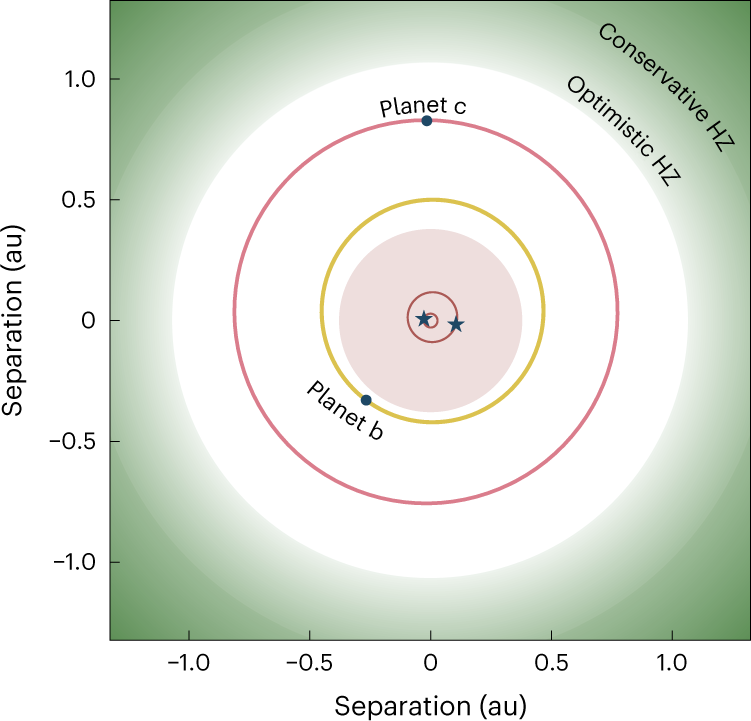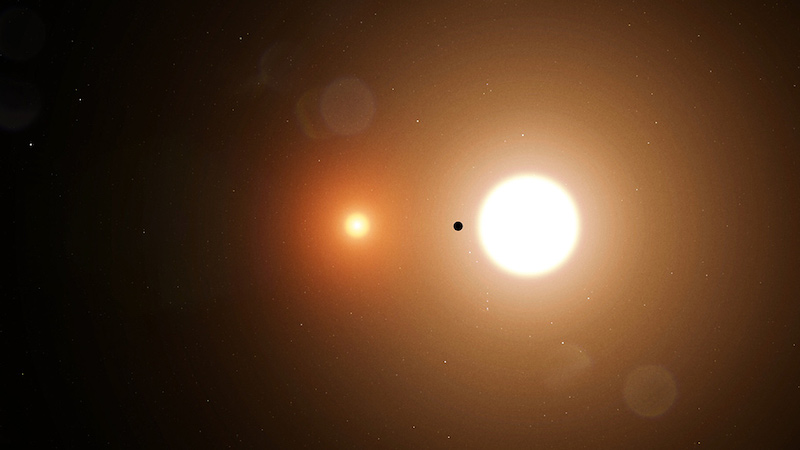
Some planets orbit two stars, reminiscent of the iconic view from the planet Tatooine in the movie Star Wars. Astronomers call such worlds circumbinary planets. They’ve found only about a dozen such systems so far. And, of those, only one has more than one planet. On June 12, 2023, researchers said they’ve spotted the 2nd-known circumbinary system with two planets. It has the great name BEBOP-1.
Researchers at the University of Birmingham in the U.K. led the team that made the discovery.
The researchers published their peer-reviewed findings in Nature Astronomy on June 12.
1st planet discovered in 2020
The BEBOP-1 system is about 1,300 light-years away in the constellation Pictor. Astronomers already knew that the system, also known as TOI-1338, has at least one planet, BEBOP-1b. NASA’s TESS space telescope discovered it in 2020, using the transit method. The astronomers observed it transit, or pass in front of, the brighter of the two stars several times. Lead author Matthew Standing at the Open University and formerly at the University of Birmingham stated:
The transit method permitted us to measure the size of TOI-1338b, but not its mass, which is the planet’s most fundamental parameter.
Discovering a new circumbinary planet was exciting, of course, but this was the only planet the researchers knew of at the time. Was it alone, or did it have companions?
A multiplanetary circumbinary system like Tatooine
It didn’t take too long to get the answer. BEBOP-1 is indeed a multiplanetary system.
At the same time that the researchers using TESS were studying the data about BEBOP-1b, another group of researchers, the BEBOP team, were monitoring the system using the Atacama Large Millimeter/submillimeter Array (ALMA) telescopes in the Atacama desert in Chile. They were attempting to measure the mass of BEBOP-1b. They did so by using a different planet detection technique called the Doppler method, aka the radial velocity method. Astronomers can detect the presence of planets by measuring how much the host star “wobbles” due to the slight gravitational influence on it of any orbiting planets. Standing’s supervisor at the time, Amaury Triaud at the University of Birmingham, said:
This is the same method that led to the first exoplanet detection, for which Mayor and Queloz received the Nobel Prize in 2019.
Those efforts to figure out the planet’s mass didn’t pan out, unfortunately. However, they did find something else exciting … a second planet!
This second planet, BEBOP-1c, joins a small group of other known circumbinary planets and an even smaller group of those planets in multi-planet systems. As David Martin at Ohio State University said:
Only 12 circumbinary systems are known so far, and this is only the second that hosts more than one planet.
BEBOP-1c
So, what is this circumbinary world like? Standing said:
BEBOP-1c has an orbital period of 215 days, and a mass 65 times larger than Earth, which is about five times less than Jupiter’s mass.
The astronomers do not yet know the size of BEBOP-1c. They will try to determine that with additional observations using the transit method.
Detecting BEBOP-1c wasn’t easy, partly due to the COVID-19 pandemic, as Standing explained:
This was a difficult system to confirm, and our observations were interrupted by the COVID pandemic when telescopes in Chile closed for six months during a critical part of the planet’s orbit. This part of the orbit only became observable again last year, when we finalized the detection.

Tatooine planetary systems provide clues about planet formation
Even though they are rarer, circumbinary planetary systems can provide valuable clues about planet formation. The idea of planets orbiting two stars at once was once only in the movies, like Star Wars. But now we know they really do exist. So how do these systems form? As co-author Lalitha Sairam at the University of Birmingham explained:
Planets are born in a disk of matter surrounding a young star, where mass progressively gathers into planets. In the case of circumbinary geometries, the disk surrounds both stars. As both stars orbit one another, they act like a giant paddle that disturbs the disk close to them and prevents planet formation except for in regions that are quiet and far away from the binary. It is easier to pinpoint the location and conditions of planet formation in circumbinary systems compared to single stars like the sun.
The researchers did also gain some new insight into the second planet, BEBOP-1b. They were able to place upper limits on its mass, and noticed that its density is, interestingly, less than that of a Victoria sponge cake, the researchers said. The researchers noted that makes it an ideal target for NASA’s Webb Space Telescope.

Bottom line: An international team of astronomers says it has found the 2nd-known Tatooine-like multiplanetary system. At least 2 planets orbit both binary stars at once.
Source: Radial-velocity discovery of a second planet in the TOI-1338/BEBOP-1 circumbinary system











